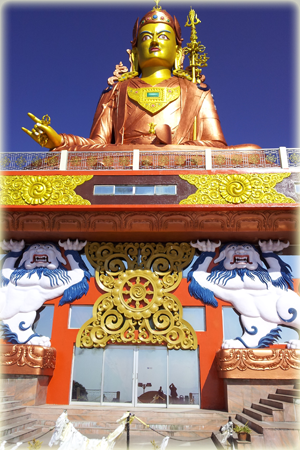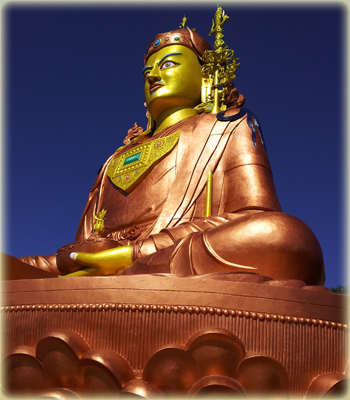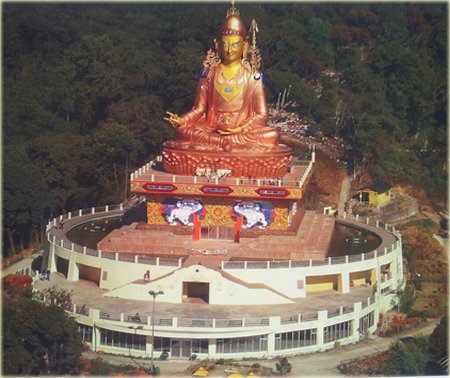|
History of Guru Rinpoche
Guru Padmasambhava was known in Tibet as one of the founding fathers of Tibetan Buddhism, who appeared in Tibet in 749 A.D, and spent 54 years. Other two founders were Acharya Shanta Rakshita and prevalent King Thisong Deotsen.
Padmasambhava’s birth in this world was mixed with myth and legend. The Buddha Shakya Muni’s prophecy about the emanation of Padmasambhava in this world was found recorded in various Sutra and Tantra Texts. Following is one of the records maintained in a Sutra called- “Myang-hDas-mDo”:
“OH MY ASHUSMAN DISCIPLE ANANDA AND OTHERS!
AFTER MY PASSING AWAY,
THAT IS TWELVE YEARS LATER, (It may perhaps referring to twelve hundred years)
A PERSON FAR SUPERIOR TO ME WHO WOULD BE THE LORD OF MASS,
NAMED PADMASAMBHAVA WILL BE EMANATED.
LIKE A GEM FROM THE SEA
LIKE USHNISHA VIJAYA AMONG MEDICINAL DIVINITIES
LIKE SUN AND MOON AMONG THE CLUSTERS OF STARS
LIKE A LION AMONG THE BEASTS AND
LIKE A GAUDA (king of birds) AMONG THE BIRDS.”
It is said that from the Western Blissful Paradise, Buddha Amitabha had committed to take birth in the incarnate form of Padmasambhava for the welfare of sentient beings in the Jambu Dwipa , the spiritual country of Buddha Shakya Muni. The lord Amitabha chooses his birth-place in ‘Dhanakosa Lake ’ in ancient Urgen Country, which is spiritually believed to be a sacrosanct place of Vidhya-dhara, cardinal cemetery of eight great cemeteries and also regarded a centre of Ten Abodes of Heruka Deities.
|
 |
| As per the text called- ‘rNam-Thar- Zangs-gling’ the Buddha Amitabhava further chosen King Indra Bhuti of Urgen country as his father since he was a Chakravarti Raja embodied with the knowledge of both civil and religious laws, and untouched by denigration to his nature and character. The so called king had no heir although he possesses a large number of queens. As advised by his courtiers the King used his wealth in charity to get himself blessed with child. Obviously, at the end, his entire treasures were exhausted. But he still finds the beggars and mendicants in ques. In order to procure more wealth he proceeded to Naga Island in the Sea to meet the Serpent Queen to beg for the wishful filing gem. The Serpent queen after having listened to the story of the king felt pity and gave away her most precious gem which produces wealth. While on his way back to Palace he and his crew members came across a lake where a wonderful child about 8 years old was sitting inside a multi-coloured Lotus. Amazingly, the child talks like that of a matured person. The king, after interaction with this divine-child, asked him to be his heir, which the child agreed. As per the text called- ‘Phurpa gNam-lChag spu-Gri’ it is described thus:- “Untouched by the defilement of mother’s womb, the Lord took a miraculous birth from the Lotus” After reaching the Palace, the child was ceremoniously placed on the golden throne. Afterwards, king made his wishes by rubbing the gem and his treasure house was refilled with wealth. Then he resumed his charity and satisfied all who came for alms. |
 | Time went by and Padmasambhava has been grown up to a young man. He thought, if he becomes a king he cannot give mass spiritual benefit to human kind. If he deserts the kingly possession and gain spiritual knowledge, he could disseminate Esoteric Doctrine to lot of yearning practitioners. So in order to get out of the palace he performs a mystic dance on the terrace of the palace with a trident in hand and pretended it fallen off from his hand, which killed the son of a malevolent minister, below. Following which, Padmasambhava was banished to ‘Silwa-Tsal cemetery, situated in the eastern direction of Urgen country as per the law of the king’s court.
Padmasambhava did his mystic practices in number of scary cemeteries like Silwa tsal, Gawo Tsal, Sosaling etc. living his life on cloths and food stuffs of deceased and thereby enhanced his spiritual power. He acquired intensive knowledge on three folds of Yoga tantra from various Buddhist Tantric Saints living in different holy places of India. He earned eight different names in different deeds as ‘Guru Tsen- Gyad’.
He specialized in the teachings of Ka-gyad Dershek Dupa, which is a collective term used to denote the group of the deities of eight Sadhana teachings associated with Eight Chief Tutelary Deities of the Mahayoga Tantra. Guru Padmasambhava obtained these Sadhana Teachings from Indian Buddhist Masters or Vidhyadharas and later transmitted to his chief Tibetan disciples for practicing upon this Sadhana. During the erstwhile Kingdom, Ka-Gyad was adopted as Chogyal’s (King) Tutelary Deity and its ceremony was held at Royal Chapel at Gangtok. During which time Government declared two days holidays in the name of ‘Ka-Gyad dance’ to enable the employees to attend the festival.
|
| One of the magnificent deeds he had performed in Himachal Pradesh is at present Riwalsar Lake where he was burnt alive upon the piles of Sandal wood with large amount of mustard oil by the order of then King. But as a matter of surprise to the king, he was unaffected by the fire and converted the mustard oil to a lake, and himself seated on Lotus petal floated on the surface of the lake. The king deeply impressed with his feat and embraced Buddhism.
His arrival in Tibet: In 8th century A.D. Then King Thisrong Deotsen who was incarnate of Lord Manjushri at his twenty became a staunch admirer of Buddhism and in order to propagate the same in Tibet he invited a learned Indian Teacher Shanta Rakshita. The master began his teaching on rTen-hBrel bChunyi (twelve dependent origination) and Gewa Chu (ten Virtues). As an oath of loyalty to the cause of Buddhism, The King committed to construct a monastery and soon started its construction. But local demons and evil spirits cast obstacles and hindered its progress. Whatever was built in the day time by human beings was destroyed by demons at night. This incident disheartened the king but Shanta Rakshita consoled the king to keep courage and advised him to invite Guru Padmasambhava to tackle the evils. Although Shanta Rakshita was well versed in outer and inner Doctrine yet it was his inability to deal with the powerful local demons. He further narrated to the king about the relation of both of them with the Guru Padmasambhava in previous life and destined to meet in Tibet to consolidate Buddhism. After having learnt this fact the King sent an envoy called Bami Thiser with present to invite Guru Padmasambhava. The Guru however knew about this and went swiftly from Nepal to the Dzara bagya cave in Mangyul, a district in upper Tibet bordering Nepal, where the envoy met him and apprised the guru of king’s wishes. In Tibet Guru subjugated all the evils under his domain and succeeded in completing Samye Monastery. From this monastery he propagated Buddha’s doctrine with the help of Shanta Rakshita fulfilling the wishes of King Thisrong Deotsen.
|
| His visit to Sikkim: Guru Padmasambhava after completing his spiritual mission in Tibet selected four major hidden lands and four minor hidden lands around Tibet. During his quest for hidden lands around Tibet, paid visit to this land along with his twenty five disciples. The purpose of looking for hidden land was to prepare spiritual resorts for the Dharma practitioners who would be taking refuge in these lands in future when Dharma declines with the approach of degenerate age (sNyigs-ma lNga) in Tibet. Guru made his first visit to present Guru Dongmar Lake in North Sikkim to test an omen in the Lake. After finding a favourable sign in the lake, he miraculously landed on Tashidhing hill in west Sikkim, along with his 25 disciples and thereby sanctified entire landscape while marking this hill as a navel point of the sacred land- ‘De-jong’. Thereafter, the Guru explored the entire parts of De-jong blessing and sanctifying caves, rock, lakes, streams and left his foot prints on the rocks. |
 |
He also concealed many religious treasures in its major places of worship for future spiritual followers. At the same time exorcised a number of Demons, Nagas and Yakshas who attempted to hinder his spiritual works and thereby inducted them in the class of the “Ney-Dag Cho-Sung” (the guardian of the sacred places and the defender of Dharma). After consecrating entire holy places he made his last wish to reappear in this sacred land in three incarnate forms in times to come as ‘Naljor Che-Zhi’ to disseminate Buddhas doctrine to his future followers.
About 1372 A.D, one treasure revealer lama called Rigdzin Goedem visited this land, revealed many treasure-texts for restoring Gurus precious teachings and also wrote about the location of the Sacred places, which had been useful to the lamas of later eras.
In1642 A.D, arrived three Noble Saints from Tibet who were known as (i) Gyalwa Lhatsun Chenpo, (ii) Ngadag Sempa Rigzin Phuntshog and (iii) Kathog Kuntu Zangpo. They entered this sacred land from north, south and western gates as a religious way of opening a sacred land in order to carry out their holy mission to introduce Buddhism. The three Lamas first assembled at a place called NORBU GANG in western Sikkim which was later called “Yuksam” by the then living Lepchas. The lamas, acting in anticipation of Lord Guru’s prophecy, sent a search party towards the east direction to find the fourth person destined to be the Chogyal or Dharma king of this land. The party wandering through the stiff hills and valleys reached finally at present Gangtok and found the man called “Phuntshog” as mentioned in the prophecy text. They first conveyed to Phuntshog the message sent by the Noble Saints. Shortly afterwards, Phuntshog left for Yuksam with his family and attendants. The Three Lamas welcomed him and accordingly consecrated “Phuntshog” as Chogyal of Demo-jong in Water-Horse year which corresponds to 1642 A.D. Four of them were known in the history as “rNal-hByor-mChed-bZhi” or Four Yogi Brothers”. The stone thrones of the four Yogi Brothers are still stand at Norbugang at Yuksam as a milestone in the history of Sikkim. In the same year, the three lamas built a stupa at Norbugang incorporating rocks and soils collected from all parts of Sikkim to mark this important event and called it “TASHI-HODBAR CHHOEDTEN”. This Chodten may be a first Buddhist Stupa ever built in Sikkim.
With the blessing of those three pioneer lamas Six premiers monasteries were founded i.e. Pemayangtse (West),Tashiding(West), Phensang (North), Ralong (South), Rumtek (East) and Phodang (North).
In course of time, many other sub monasteries and religious monuments were built by the lamas and Devotees. Today images/idols of Guru Padmasambhava are found enshrined in each and every monastery in Sikkim as main worshipping objects by the lamas. Especially on tenth day of every Tibetan month Guru Tsechu puja is performed to mark his birth anniversary as well as to pray for peace & prosperity of this land.
|
| |